Reflective Essay: Analysis of Clinical Experiences in Nursing
VerifiedAdded on 2023/04/21
|8
|2274
|174
Essay
AI Summary
This reflective essay provides an in-depth analysis of a nursing student's clinical experiences. The essay begins by discussing a critical incident involving a medication error, highlighting the importance of meticulous care and the potential consequences of negligence. The student then reflects on the significance of accurate documentation, particularly in the context of patient discharge planning, and the challenges posed by language barriers and cultural differences. The essay also explores the complexities of patient assessment, emphasizing the impact of cultural sensitivity and communication. The student reflects on the need for continuous learning and professional development to enhance cultural awareness and improve patient care. Through these experiences, the student identifies personal strengths and weaknesses, demonstrating a commitment to growth and excellence in nursing practice. The essay concludes with a reaffirmation of the importance of reflective practice in shaping a successful nursing career.
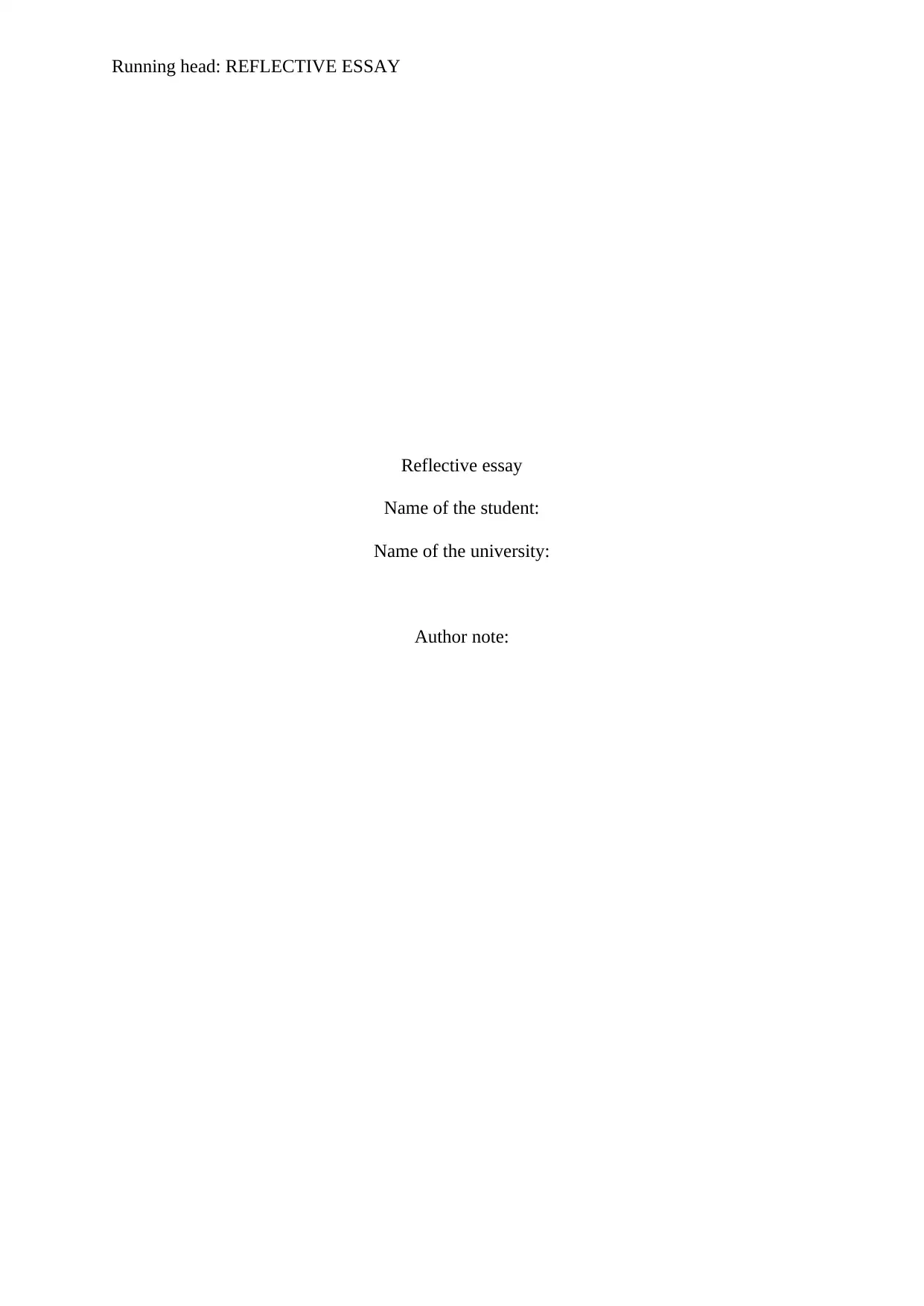
Running head: REFLECTIVE ESSAY
Reflective essay
Name of the student:
Name of the university:
Author note:
Reflective essay
Name of the student:
Name of the university:
Author note:
Paraphrase This Document
Need a fresh take? Get an instant paraphrase of this document with our AI Paraphraser
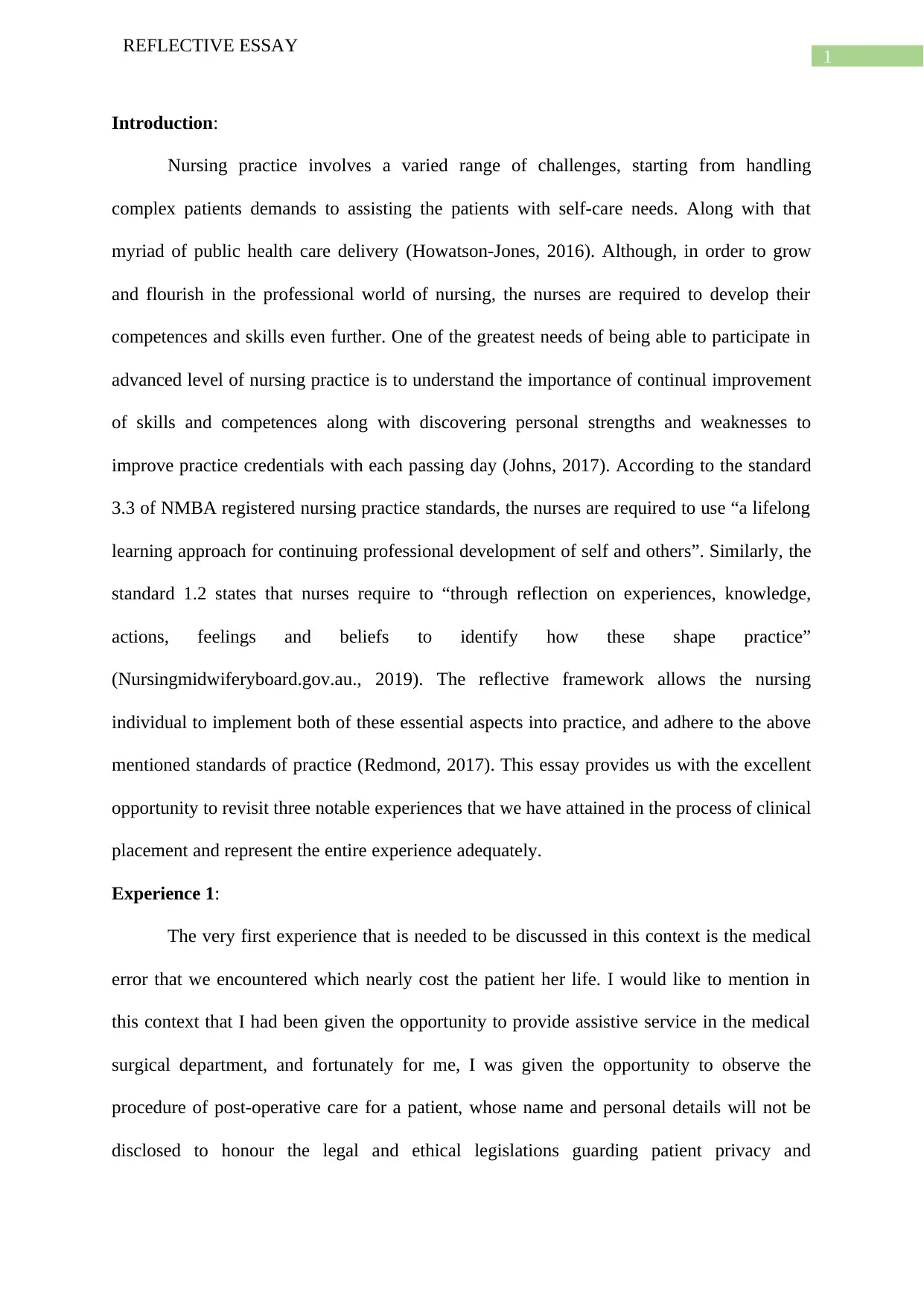
1
REFLECTIVE ESSAY
Introduction:
Nursing practice involves a varied range of challenges, starting from handling
complex patients demands to assisting the patients with self-care needs. Along with that
myriad of public health care delivery (Howatson-Jones, 2016). Although, in order to grow
and flourish in the professional world of nursing, the nurses are required to develop their
competences and skills even further. One of the greatest needs of being able to participate in
advanced level of nursing practice is to understand the importance of continual improvement
of skills and competences along with discovering personal strengths and weaknesses to
improve practice credentials with each passing day (Johns, 2017). According to the standard
3.3 of NMBA registered nursing practice standards, the nurses are required to use “a lifelong
learning approach for continuing professional development of self and others”. Similarly, the
standard 1.2 states that nurses require to “through reflection on experiences, knowledge,
actions, feelings and beliefs to identify how these shape practice”
(Nursingmidwiferyboard.gov.au., 2019). The reflective framework allows the nursing
individual to implement both of these essential aspects into practice, and adhere to the above
mentioned standards of practice (Redmond, 2017). This essay provides us with the excellent
opportunity to revisit three notable experiences that we have attained in the process of clinical
placement and represent the entire experience adequately.
Experience 1:
The very first experience that is needed to be discussed in this context is the medical
error that we encountered which nearly cost the patient her life. I would like to mention in
this context that I had been given the opportunity to provide assistive service in the medical
surgical department, and fortunately for me, I was given the opportunity to observe the
procedure of post-operative care for a patient, whose name and personal details will not be
disclosed to honour the legal and ethical legislations guarding patient privacy and
REFLECTIVE ESSAY
Introduction:
Nursing practice involves a varied range of challenges, starting from handling
complex patients demands to assisting the patients with self-care needs. Along with that
myriad of public health care delivery (Howatson-Jones, 2016). Although, in order to grow
and flourish in the professional world of nursing, the nurses are required to develop their
competences and skills even further. One of the greatest needs of being able to participate in
advanced level of nursing practice is to understand the importance of continual improvement
of skills and competences along with discovering personal strengths and weaknesses to
improve practice credentials with each passing day (Johns, 2017). According to the standard
3.3 of NMBA registered nursing practice standards, the nurses are required to use “a lifelong
learning approach for continuing professional development of self and others”. Similarly, the
standard 1.2 states that nurses require to “through reflection on experiences, knowledge,
actions, feelings and beliefs to identify how these shape practice”
(Nursingmidwiferyboard.gov.au., 2019). The reflective framework allows the nursing
individual to implement both of these essential aspects into practice, and adhere to the above
mentioned standards of practice (Redmond, 2017). This essay provides us with the excellent
opportunity to revisit three notable experiences that we have attained in the process of clinical
placement and represent the entire experience adequately.
Experience 1:
The very first experience that is needed to be discussed in this context is the medical
error that we encountered which nearly cost the patient her life. I would like to mention in
this context that I had been given the opportunity to provide assistive service in the medical
surgical department, and fortunately for me, I was given the opportunity to observe the
procedure of post-operative care for a patient, whose name and personal details will not be
disclosed to honour the legal and ethical legislations guarding patient privacy and

2
REFLECTIVE ESSAY
confidentiality (Goulet, Larue & Alderson, 2016).
In the entire experience I was extremely giddy with excitement and nervousness as it
had been my very first encounter of observing post-operative care and maintenance in action.
Similarly, it had also been one of the greatest responsibilities bestowed on me and I had been
determined to prove myself to be deserving of the opportunity. I had been very attentive and I
researched excessively on vital sign assessment, medication administration and ensuring
comfort for the patient, which are also three core functions needed to be performed by the
nurses had been the most important responsibilities for medical surgical nursing, especially
when practicing in the medical surgical department. As I was assisting in the process, I was
also given the opportunity to document and review the medication administration with the
dosages to ensure utmost safety and efficacy of the care planning and implementation.
However, this opportunity also allowed me to notice a grave mistake that has been committed
while providing care to the patient. She had been indicated for using diclofenac as pain
medication, which while administered that nurse mistakenly doubled the dosage (Pfeiffer et
al., 2016). Although, the issue had been a misinterpretation of the dosage originally indicated
for use. As soon I noticed I knew that the pain medication given had been overdosed and it
can lead to a variety of complexities.
Although, it had been an extremely difficult decision to be taken concerning the fact
that the nurse who had originally committed the error had been an elderly nurse who had
been very sweet and welcoming to me. Although, the patient’s life and wellbeing had been at
risk in this situation and hence, I had immediately communicated with the nurse in question
and together we concerned the nurse manager and antidote for the over-dosage was given to
the patient, which saved her life (Dubé & Ducharme, 2015). From this experience, I learned
even the slightest of errors or negligence in the nursing care practice can lead to many
complications and can even threaten the life of the patient.
REFLECTIVE ESSAY
confidentiality (Goulet, Larue & Alderson, 2016).
In the entire experience I was extremely giddy with excitement and nervousness as it
had been my very first encounter of observing post-operative care and maintenance in action.
Similarly, it had also been one of the greatest responsibilities bestowed on me and I had been
determined to prove myself to be deserving of the opportunity. I had been very attentive and I
researched excessively on vital sign assessment, medication administration and ensuring
comfort for the patient, which are also three core functions needed to be performed by the
nurses had been the most important responsibilities for medical surgical nursing, especially
when practicing in the medical surgical department. As I was assisting in the process, I was
also given the opportunity to document and review the medication administration with the
dosages to ensure utmost safety and efficacy of the care planning and implementation.
However, this opportunity also allowed me to notice a grave mistake that has been committed
while providing care to the patient. She had been indicated for using diclofenac as pain
medication, which while administered that nurse mistakenly doubled the dosage (Pfeiffer et
al., 2016). Although, the issue had been a misinterpretation of the dosage originally indicated
for use. As soon I noticed I knew that the pain medication given had been overdosed and it
can lead to a variety of complexities.
Although, it had been an extremely difficult decision to be taken concerning the fact
that the nurse who had originally committed the error had been an elderly nurse who had
been very sweet and welcoming to me. Although, the patient’s life and wellbeing had been at
risk in this situation and hence, I had immediately communicated with the nurse in question
and together we concerned the nurse manager and antidote for the over-dosage was given to
the patient, which saved her life (Dubé & Ducharme, 2015). From this experience, I learned
even the slightest of errors or negligence in the nursing care practice can lead to many
complications and can even threaten the life of the patient.
⊘ This is a preview!⊘
Do you want full access?
Subscribe today to unlock all pages.

Trusted by 1+ million students worldwide
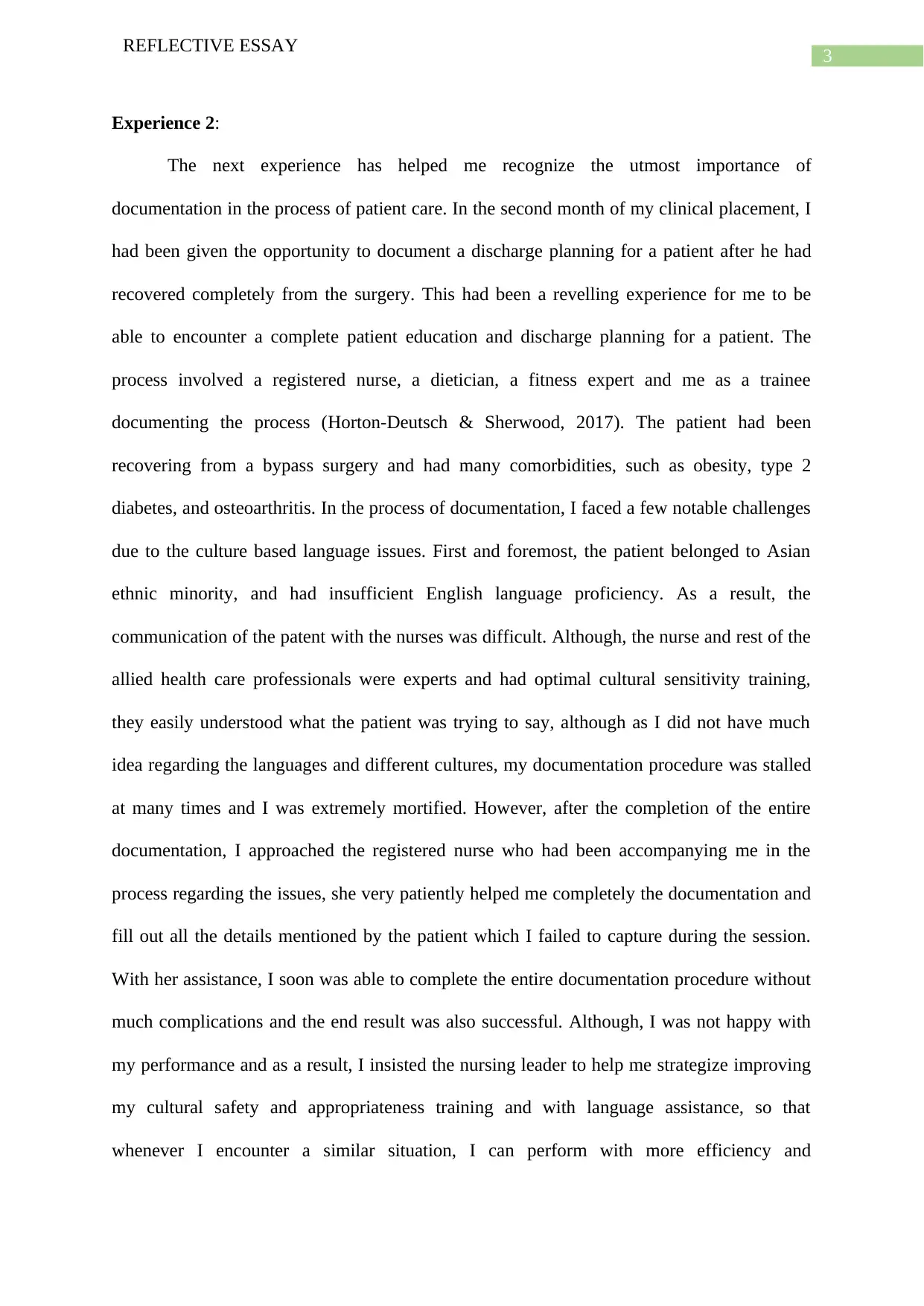
3
REFLECTIVE ESSAY
Experience 2:
The next experience has helped me recognize the utmost importance of
documentation in the process of patient care. In the second month of my clinical placement, I
had been given the opportunity to document a discharge planning for a patient after he had
recovered completely from the surgery. This had been a revelling experience for me to be
able to encounter a complete patient education and discharge planning for a patient. The
process involved a registered nurse, a dietician, a fitness expert and me as a trainee
documenting the process (Horton-Deutsch & Sherwood, 2017). The patient had been
recovering from a bypass surgery and had many comorbidities, such as obesity, type 2
diabetes, and osteoarthritis. In the process of documentation, I faced a few notable challenges
due to the culture based language issues. First and foremost, the patient belonged to Asian
ethnic minority, and had insufficient English language proficiency. As a result, the
communication of the patent with the nurses was difficult. Although, the nurse and rest of the
allied health care professionals were experts and had optimal cultural sensitivity training,
they easily understood what the patient was trying to say, although as I did not have much
idea regarding the languages and different cultures, my documentation procedure was stalled
at many times and I was extremely mortified. However, after the completion of the entire
documentation, I approached the registered nurse who had been accompanying me in the
process regarding the issues, she very patiently helped me completely the documentation and
fill out all the details mentioned by the patient which I failed to capture during the session.
With her assistance, I soon was able to complete the entire documentation procedure without
much complications and the end result was also successful. Although, I was not happy with
my performance and as a result, I insisted the nursing leader to help me strategize improving
my cultural safety and appropriateness training and with language assistance, so that
whenever I encounter a similar situation, I can perform with more efficiency and
REFLECTIVE ESSAY
Experience 2:
The next experience has helped me recognize the utmost importance of
documentation in the process of patient care. In the second month of my clinical placement, I
had been given the opportunity to document a discharge planning for a patient after he had
recovered completely from the surgery. This had been a revelling experience for me to be
able to encounter a complete patient education and discharge planning for a patient. The
process involved a registered nurse, a dietician, a fitness expert and me as a trainee
documenting the process (Horton-Deutsch & Sherwood, 2017). The patient had been
recovering from a bypass surgery and had many comorbidities, such as obesity, type 2
diabetes, and osteoarthritis. In the process of documentation, I faced a few notable challenges
due to the culture based language issues. First and foremost, the patient belonged to Asian
ethnic minority, and had insufficient English language proficiency. As a result, the
communication of the patent with the nurses was difficult. Although, the nurse and rest of the
allied health care professionals were experts and had optimal cultural sensitivity training,
they easily understood what the patient was trying to say, although as I did not have much
idea regarding the languages and different cultures, my documentation procedure was stalled
at many times and I was extremely mortified. However, after the completion of the entire
documentation, I approached the registered nurse who had been accompanying me in the
process regarding the issues, she very patiently helped me completely the documentation and
fill out all the details mentioned by the patient which I failed to capture during the session.
With her assistance, I soon was able to complete the entire documentation procedure without
much complications and the end result was also successful. Although, I was not happy with
my performance and as a result, I insisted the nursing leader to help me strategize improving
my cultural safety and appropriateness training and with language assistance, so that
whenever I encounter a similar situation, I can perform with more efficiency and
Paraphrase This Document
Need a fresh take? Get an instant paraphrase of this document with our AI Paraphraser
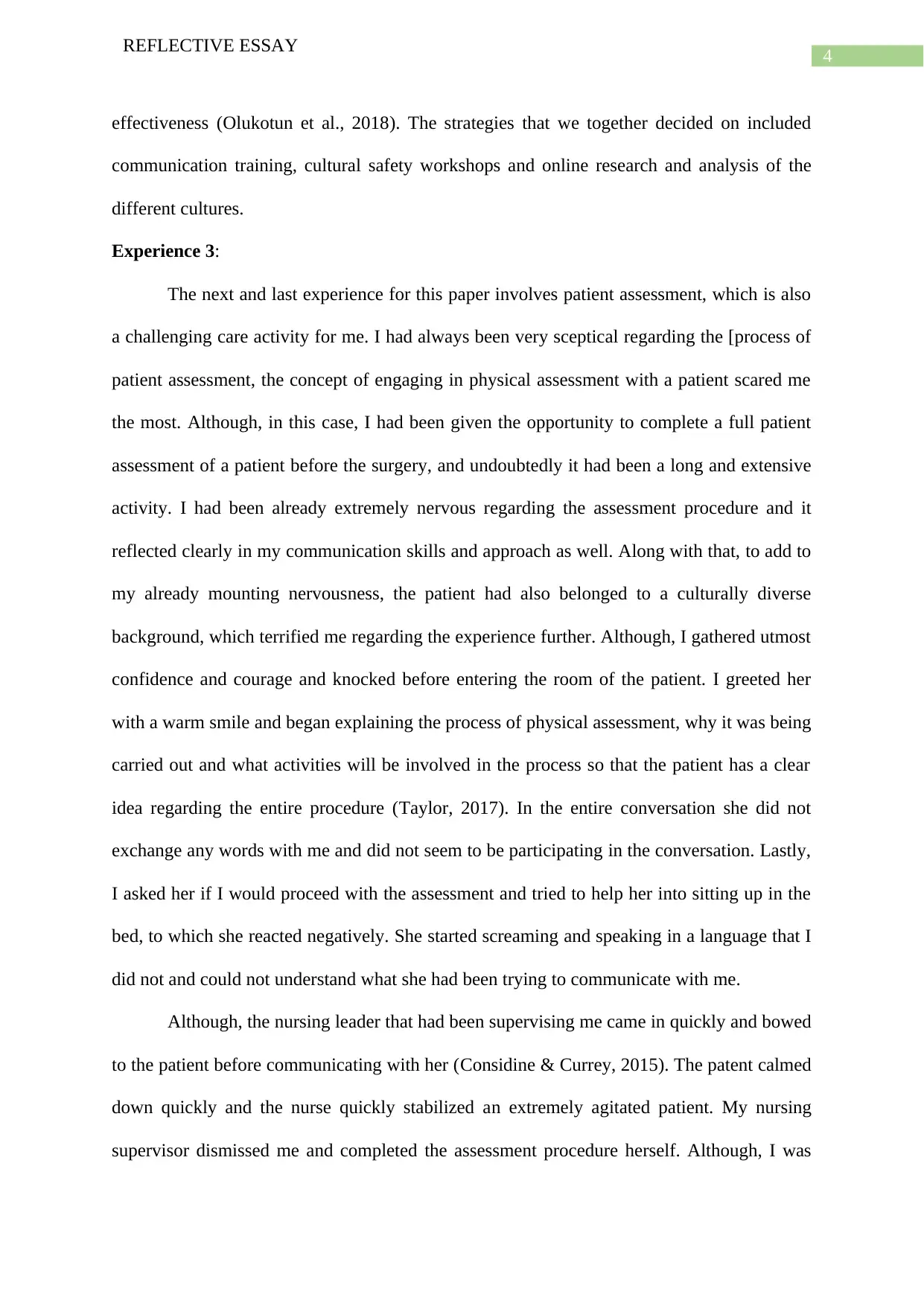
4
REFLECTIVE ESSAY
effectiveness (Olukotun et al., 2018). The strategies that we together decided on included
communication training, cultural safety workshops and online research and analysis of the
different cultures.
Experience 3:
The next and last experience for this paper involves patient assessment, which is also
a challenging care activity for me. I had always been very sceptical regarding the [process of
patient assessment, the concept of engaging in physical assessment with a patient scared me
the most. Although, in this case, I had been given the opportunity to complete a full patient
assessment of a patient before the surgery, and undoubtedly it had been a long and extensive
activity. I had been already extremely nervous regarding the assessment procedure and it
reflected clearly in my communication skills and approach as well. Along with that, to add to
my already mounting nervousness, the patient had also belonged to a culturally diverse
background, which terrified me regarding the experience further. Although, I gathered utmost
confidence and courage and knocked before entering the room of the patient. I greeted her
with a warm smile and began explaining the process of physical assessment, why it was being
carried out and what activities will be involved in the process so that the patient has a clear
idea regarding the entire procedure (Taylor, 2017). In the entire conversation she did not
exchange any words with me and did not seem to be participating in the conversation. Lastly,
I asked her if I would proceed with the assessment and tried to help her into sitting up in the
bed, to which she reacted negatively. She started screaming and speaking in a language that I
did not and could not understand what she had been trying to communicate with me.
Although, the nursing leader that had been supervising me came in quickly and bowed
to the patient before communicating with her (Considine & Currey, 2015). The patent calmed
down quickly and the nurse quickly stabilized an extremely agitated patient. My nursing
supervisor dismissed me and completed the assessment procedure herself. Although, I was
REFLECTIVE ESSAY
effectiveness (Olukotun et al., 2018). The strategies that we together decided on included
communication training, cultural safety workshops and online research and analysis of the
different cultures.
Experience 3:
The next and last experience for this paper involves patient assessment, which is also
a challenging care activity for me. I had always been very sceptical regarding the [process of
patient assessment, the concept of engaging in physical assessment with a patient scared me
the most. Although, in this case, I had been given the opportunity to complete a full patient
assessment of a patient before the surgery, and undoubtedly it had been a long and extensive
activity. I had been already extremely nervous regarding the assessment procedure and it
reflected clearly in my communication skills and approach as well. Along with that, to add to
my already mounting nervousness, the patient had also belonged to a culturally diverse
background, which terrified me regarding the experience further. Although, I gathered utmost
confidence and courage and knocked before entering the room of the patient. I greeted her
with a warm smile and began explaining the process of physical assessment, why it was being
carried out and what activities will be involved in the process so that the patient has a clear
idea regarding the entire procedure (Taylor, 2017). In the entire conversation she did not
exchange any words with me and did not seem to be participating in the conversation. Lastly,
I asked her if I would proceed with the assessment and tried to help her into sitting up in the
bed, to which she reacted negatively. She started screaming and speaking in a language that I
did not and could not understand what she had been trying to communicate with me.
Although, the nursing leader that had been supervising me came in quickly and bowed
to the patient before communicating with her (Considine & Currey, 2015). The patent calmed
down quickly and the nurse quickly stabilized an extremely agitated patient. My nursing
supervisor dismissed me and completed the assessment procedure herself. Although, I was
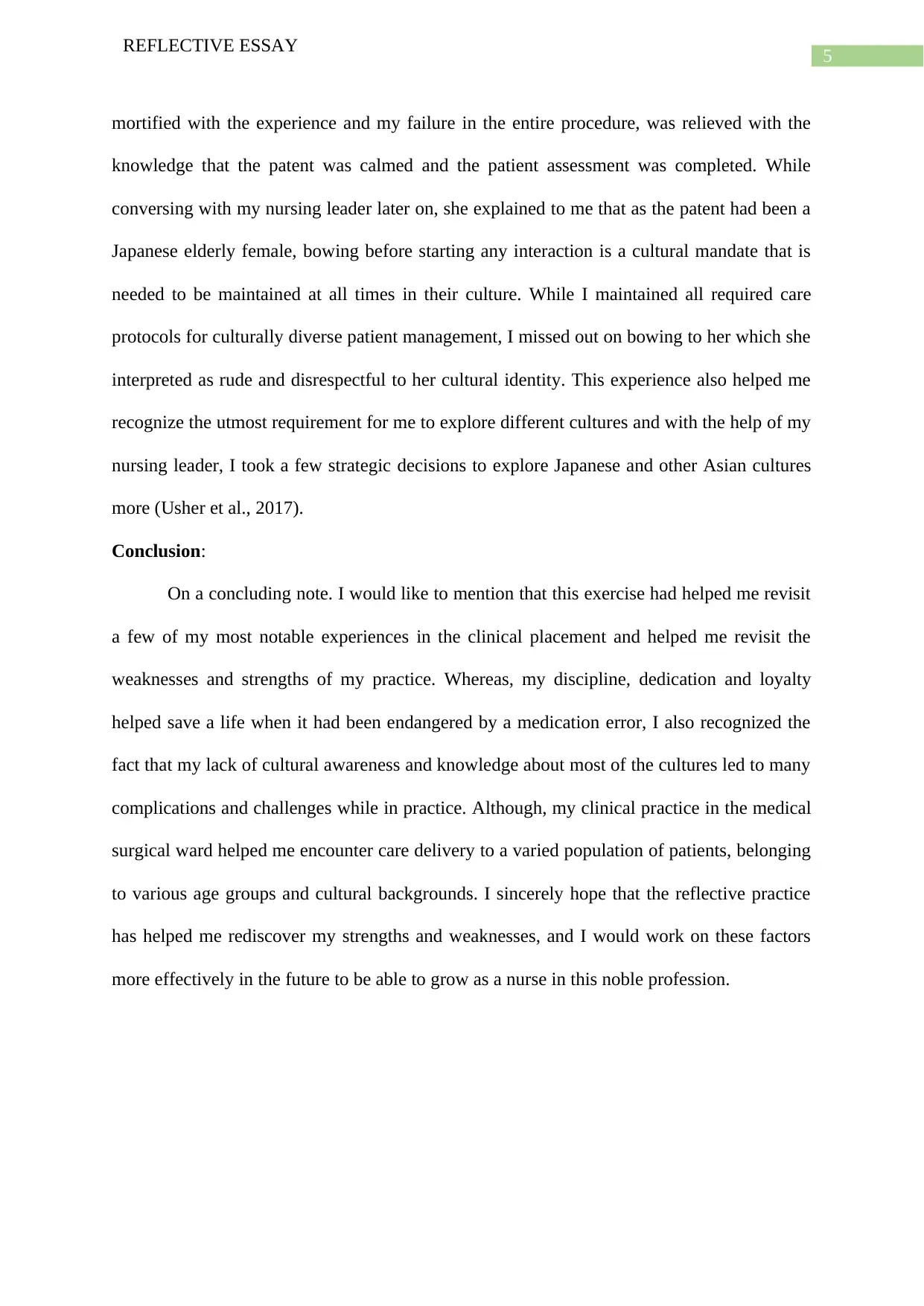
5
REFLECTIVE ESSAY
mortified with the experience and my failure in the entire procedure, was relieved with the
knowledge that the patent was calmed and the patient assessment was completed. While
conversing with my nursing leader later on, she explained to me that as the patent had been a
Japanese elderly female, bowing before starting any interaction is a cultural mandate that is
needed to be maintained at all times in their culture. While I maintained all required care
protocols for culturally diverse patient management, I missed out on bowing to her which she
interpreted as rude and disrespectful to her cultural identity. This experience also helped me
recognize the utmost requirement for me to explore different cultures and with the help of my
nursing leader, I took a few strategic decisions to explore Japanese and other Asian cultures
more (Usher et al., 2017).
Conclusion:
On a concluding note. I would like to mention that this exercise had helped me revisit
a few of my most notable experiences in the clinical placement and helped me revisit the
weaknesses and strengths of my practice. Whereas, my discipline, dedication and loyalty
helped save a life when it had been endangered by a medication error, I also recognized the
fact that my lack of cultural awareness and knowledge about most of the cultures led to many
complications and challenges while in practice. Although, my clinical practice in the medical
surgical ward helped me encounter care delivery to a varied population of patients, belonging
to various age groups and cultural backgrounds. I sincerely hope that the reflective practice
has helped me rediscover my strengths and weaknesses, and I would work on these factors
more effectively in the future to be able to grow as a nurse in this noble profession.
REFLECTIVE ESSAY
mortified with the experience and my failure in the entire procedure, was relieved with the
knowledge that the patent was calmed and the patient assessment was completed. While
conversing with my nursing leader later on, she explained to me that as the patent had been a
Japanese elderly female, bowing before starting any interaction is a cultural mandate that is
needed to be maintained at all times in their culture. While I maintained all required care
protocols for culturally diverse patient management, I missed out on bowing to her which she
interpreted as rude and disrespectful to her cultural identity. This experience also helped me
recognize the utmost requirement for me to explore different cultures and with the help of my
nursing leader, I took a few strategic decisions to explore Japanese and other Asian cultures
more (Usher et al., 2017).
Conclusion:
On a concluding note. I would like to mention that this exercise had helped me revisit
a few of my most notable experiences in the clinical placement and helped me revisit the
weaknesses and strengths of my practice. Whereas, my discipline, dedication and loyalty
helped save a life when it had been endangered by a medication error, I also recognized the
fact that my lack of cultural awareness and knowledge about most of the cultures led to many
complications and challenges while in practice. Although, my clinical practice in the medical
surgical ward helped me encounter care delivery to a varied population of patients, belonging
to various age groups and cultural backgrounds. I sincerely hope that the reflective practice
has helped me rediscover my strengths and weaknesses, and I would work on these factors
more effectively in the future to be able to grow as a nurse in this noble profession.
⊘ This is a preview!⊘
Do you want full access?
Subscribe today to unlock all pages.

Trusted by 1+ million students worldwide

6
REFLECTIVE ESSAY
References:
Considine, J., & Currey, J. (2015). Ensuring a proactive, evidence‐based, patient safety
approach to patient assessment. Journal of Clinical Nursing, 24(1-2), 300-307.
Dubé, V., & Ducharme, F. (2015). Nursing reflective practice: An empirical
literature. Journal of Nursing Education and Practice, 5(7).
Goulet, M. H., Larue, C., & Alderson, M. (2016, April). Reflective practice: A comparative
dimensional analysis of the concept in nursing and education studies. In Nursing
forum(Vol. 51, No. 2, pp. 139-150).
Horton-Deutsch, S., & Sherwood, G. D. (2017). Reflective practice: Transforming education
and improving outcomes(Vol. 2). Sigma Theta Tau.
Howatson-Jones, L. (2016). Reflective practice in nursing. Learning Matters.
Johns, C. (Ed.). (2017). Becoming a reflective practitioner. John Wiley & Sons.
Nursingmidwiferyboard.gov.au. (2019). Nursing and Midwifery Board of Australia -
Registered nurse standards for practice. [online] Available at:
https://www.nursingmidwiferyboard.gov.au/codes-guidelines-statements/
professional-standards/registered-nurse-standards-for-practice.aspx [Accessed 20 Feb.
2019].
Olukotun, O., Mkandawire-Vahlmu, L., Kreuziger, S. B., Dressel, A., Wesp, L., Sima, C., ...
& Kako, P. (2018). Preparing culturally safe student nurses: An analysis of
undergraduate cultural diversity course reflections. Journal of Professional
Nursing, 34(4), 245-252.
Pfeiffer, H., Herbst, L., Schwarze, B., Eckstein, R., & Weisbach, V. (2016). Massive
intoxication with rivaroxaban, phenprocoumon, and diclofenac: a case
report. Medicine, 95(44).
Redmond, B. (2017). Reflection in action: Developing reflective practice in health and social
REFLECTIVE ESSAY
References:
Considine, J., & Currey, J. (2015). Ensuring a proactive, evidence‐based, patient safety
approach to patient assessment. Journal of Clinical Nursing, 24(1-2), 300-307.
Dubé, V., & Ducharme, F. (2015). Nursing reflective practice: An empirical
literature. Journal of Nursing Education and Practice, 5(7).
Goulet, M. H., Larue, C., & Alderson, M. (2016, April). Reflective practice: A comparative
dimensional analysis of the concept in nursing and education studies. In Nursing
forum(Vol. 51, No. 2, pp. 139-150).
Horton-Deutsch, S., & Sherwood, G. D. (2017). Reflective practice: Transforming education
and improving outcomes(Vol. 2). Sigma Theta Tau.
Howatson-Jones, L. (2016). Reflective practice in nursing. Learning Matters.
Johns, C. (Ed.). (2017). Becoming a reflective practitioner. John Wiley & Sons.
Nursingmidwiferyboard.gov.au. (2019). Nursing and Midwifery Board of Australia -
Registered nurse standards for practice. [online] Available at:
https://www.nursingmidwiferyboard.gov.au/codes-guidelines-statements/
professional-standards/registered-nurse-standards-for-practice.aspx [Accessed 20 Feb.
2019].
Olukotun, O., Mkandawire-Vahlmu, L., Kreuziger, S. B., Dressel, A., Wesp, L., Sima, C., ...
& Kako, P. (2018). Preparing culturally safe student nurses: An analysis of
undergraduate cultural diversity course reflections. Journal of Professional
Nursing, 34(4), 245-252.
Pfeiffer, H., Herbst, L., Schwarze, B., Eckstein, R., & Weisbach, V. (2016). Massive
intoxication with rivaroxaban, phenprocoumon, and diclofenac: a case
report. Medicine, 95(44).
Redmond, B. (2017). Reflection in action: Developing reflective practice in health and social
Paraphrase This Document
Need a fresh take? Get an instant paraphrase of this document with our AI Paraphraser
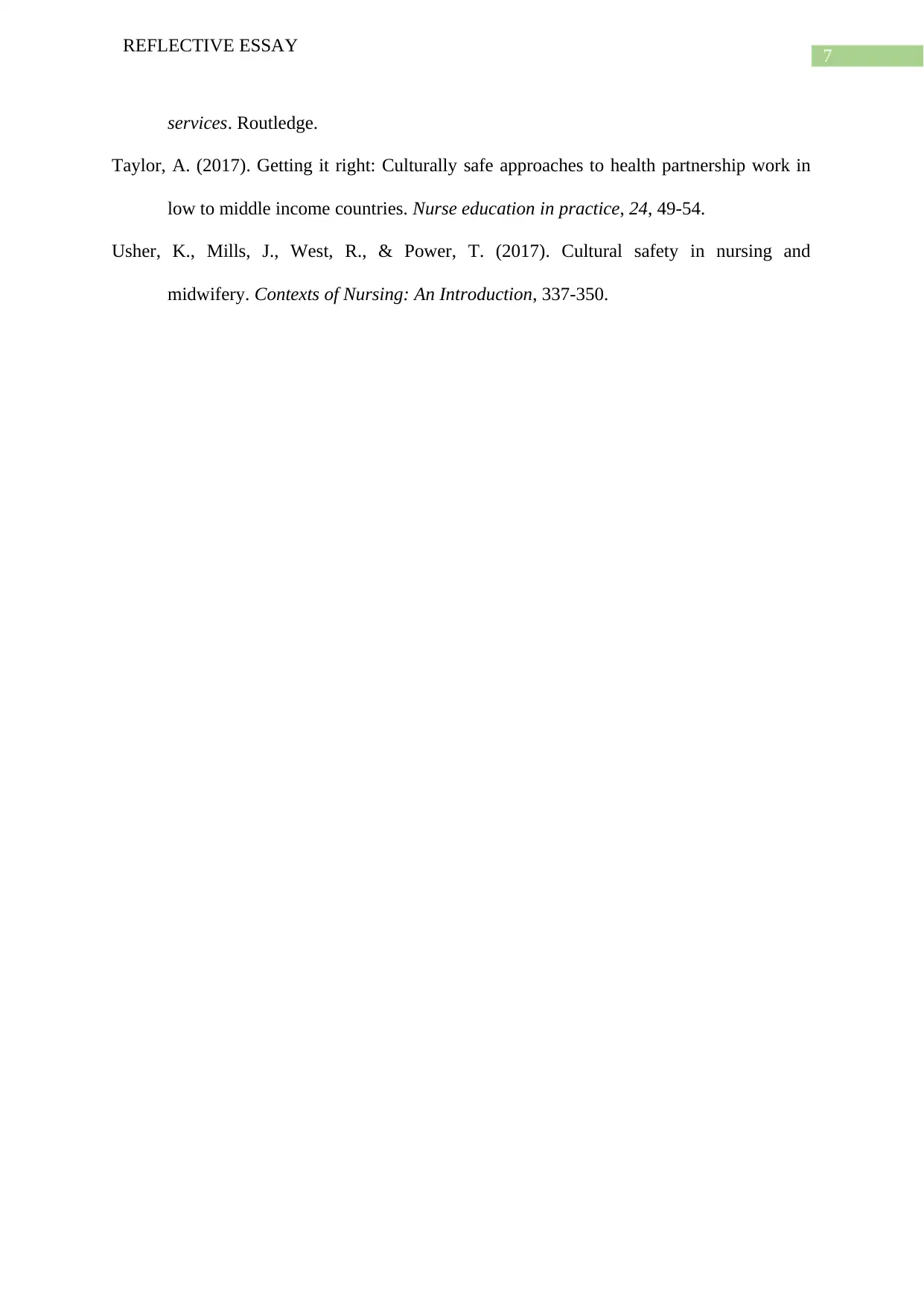
7
REFLECTIVE ESSAY
services. Routledge.
Taylor, A. (2017). Getting it right: Culturally safe approaches to health partnership work in
low to middle income countries. Nurse education in practice, 24, 49-54.
Usher, K., Mills, J., West, R., & Power, T. (2017). Cultural safety in nursing and
midwifery. Contexts of Nursing: An Introduction, 337-350.
REFLECTIVE ESSAY
services. Routledge.
Taylor, A. (2017). Getting it right: Culturally safe approaches to health partnership work in
low to middle income countries. Nurse education in practice, 24, 49-54.
Usher, K., Mills, J., West, R., & Power, T. (2017). Cultural safety in nursing and
midwifery. Contexts of Nursing: An Introduction, 337-350.
1 out of 8
Related Documents
Your All-in-One AI-Powered Toolkit for Academic Success.
+13062052269
info@desklib.com
Available 24*7 on WhatsApp / Email
![[object Object]](/_next/static/media/star-bottom.7253800d.svg)
Unlock your academic potential
Copyright © 2020–2026 A2Z Services. All Rights Reserved. Developed and managed by ZUCOL.



